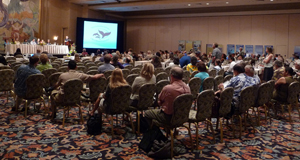ICMMPA Daily Log
Day One – March 30, 2009
Building on the momentum from day one, the attendees participated in a day filled with exciting and informative presentations and discussions. Day two was opened by a captivating traditional Aloha Kakahiaka! Hula by Halau Mohala Ilima.

Symposium 2: Managing MMPAs
Steve Gittings, Science Coordinator, NOAA Office of National Marine Sanctuaries, moderator;
Featured speakers:
Dan Basta, Director, NOAA’s Office of National Marine Sanctuaries, USA
Lorenzo Rojas-Bracho, Instituto Nacional de Ecologia, Mexico
Jorge Urban, Universidad Autonoma de Baja Californial Sur, Mexico
Giuseppe Notarbartolo di Sciara, Honorary President, Tethys Research Institution, Milano, Italy;
Spyros Kotomatas, MoM, the Hellenic Society for the Study and Protection of the Monk Seal, Greece
Rose Pires, Parque Natural da Madeira Service, Madeira
Dan Basta, in his opening remarks on the session, provided his thoughts on MMPAs in general.“To be successful, you have to connect people to the resource through stories. Marine mammals and humans have a special relationship that is different from any other animal in the sea.One whale trapped in a river is an international story, a thousand dead fish is a [human] health concern and a nuisance. So, the humpback whale can help us change the hearts and minds of the people on Planet Earth when it comes to marine conservation,” said Basta.

This symposium highlighted the issues, challenges, and different models of management for MMPAs. Some examples of the difficulties faced in MMPA management were presented. Issues included challenges based on incomplete siting of MMPAs (the Vaquita in Mexico), lack of follow-through by co-trustees (Pelagos multi-national MMPA in the Mediterranean Sea) or lack of a collective will to establish MMPAs (Monk seals in the Mediterranean). The promising recovery of Monk Seal populations in Madeira was discussed by Rosa Pires.
Panel 3: How can MPAs and Networks of MPAs Ensure Threat Mitigation to Cetaceans?
Convener: Simone Panigada, European Cetacean Society and Vice President of the Tethys Research Institute, Italy
Panelists:
Chris Gabriele, Glacier Bay National Park, Alaska, USA
David Mattilla, NOAA’s Hawaiian Islands Humpback Whale National Marine Sanctuary
Randy Reeves, Chair, IUCN Species Survival Commission, Cetacean Specialist Group, Canada
Leila Hatch, Marine Ecologist, NOAA’s Stellwagen Bank National Marine Sanctuary, USA
David Hyrenbach, Hawaii Pacific University, USA
Colleen Corrigan, UNEP World Conservation Monitoring Centre, UK
Irini Papanicolopulu, University of Milan, School of Law, Milano, Italy
Moving from MMPA management in general to the “nuts and bolts” of place-based marine conservation, Panel 3 discussed a key aspect of MMPAs.Threat mitigation is one of the goals of all MPAs and the extent to which threats are mitigated is used, in part, to gauge success.Threats must first be characterized, then monitored for success and finally management strategies must be adjusted if actions are not achieving the desired results. Several compelling case studies were presented.Ship strikes on whales, acoustic disturbance, and entanglements were all presented as major threats to cetaceans.Mitigation techniques include vessel speed reduction, re-adjustment of shipping lanes and education and outreach aimed at reducing derelict fishing gear have been utilized.

Panel 4: Managing the Balance between Commercial and Economic Interests within MPAs for Cetaceans
Convener: Naomi McIntosh, Superintendent NOAA’s Hawaiian Islands Humpback Whale National Marine Sanctuary, USA
Panelists:
Nikolai Pavlov, Director, Komondor Islands State Nature Biosphere Reserve, Russia;
Cristina Castro, Machalilla National Park, Ecuador;
Lars, Bejder, Research Fellow, Murdoch University Cetacean Research Unit, Australia;
Giuseppe Notarbartolo di Sciara, Honorary President, Tethys Research Institution, Milano, Italy;
Kauahi Ngapora, Chief Operating Officer, Kaikoura Whale Watch, Ngai, Tahu, New Zealand.
Undoubtedly, one of the most challenging aspects of managing MMPAs involves balancing the well-being of the marine mammals with commercial and economic interests. This panel provided examples of MMPAs at various stages of development and highlighted the flexibility and resourcefulness required by MMPA managers in finding the right combination of protection and public and private use. Case studies in Ecuador, Russia and New Zealand emphasized the need to provide an economic benefit to local communities in order to give momentum to resource conservation efforts. The effects of ecotourism on the mammals were discussed. Examples included Spinner dolphin populations in Hawaii and the Red Sea. There is a building amount of evidence that this species is especially vulnerable to impact from ecotourism due to the fact that, normally, they sleep in the daytime. This habit makes them easy to find…and to disturb. Naomi McIntosh announced that the Hawaiian Islands Humpback Whale National Marine Sanctuary will begin a management plan review process, kicked off by public scoping meetings in August of 2009. Existing programs will be open for comment as will the possibility of including additional resources for protection by the Sanctuary.
Panel 5: Refining Management for improved MPAs and MPA Networks
Convener: Brad Barr, NOAA’s Office of National Marine Sanctuaries, USA
Panelists:
Alessandrao Vanzella-Khouri, UNEP Caribbean Environment Programme, Jamaica
Mabel Augustowski, Environmental Department of Sao Paulo State Government, Brazil
Mike Donoghue, Department of Conservation, New Zealand
Steve Gittings, NOAA’s Office of National Marine Sanctuaries, USA
Miguel Iniguez, Fundacion Cethus, WDCS International, Argentina Alternate Commissioner, IWC, Argentina
Jorge Urban Ramirez, University of Baja California Sur, Mexico
Building on the conference theme of networking MMPAs, this panel addressed how we assess and improve management effectiveness of existing MMPAs. Presentations on the design and implementation of monitoring and evaluation programs provided insight into the methods utilized around the world in this field of marine conservation. Practitioners are faced with rapidly evolving science, policy, socioeconomic and political landscapes create the need for continuous attention to effectiveness evaluation and, if necessary, management changes. Throughout the panel, the concept of the need for understandable measures to convey management success to the public as well as government leaders was repeated. As the idea of building networks of MMPAs becomes a reality, the topics covered in this panel session will be a key factor in determining success.